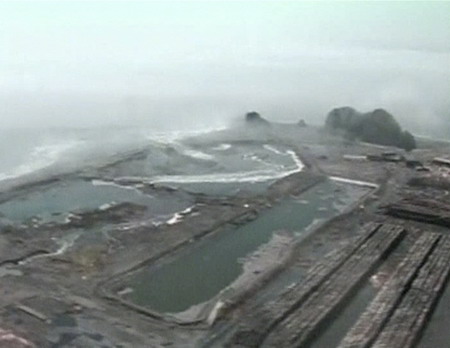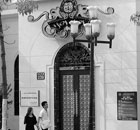Asia-Pacific
North Japan hit by 30 cm tsunami after warning
(Agencies)
Updated: 2010-02-28 15:21
 |
Large Medium Small |
|
 Waves are seen near the coastal town of Dichato, after a massive earthquake, in Chile February 27, 2010. One of the world's most powerful earthquakes in a century pounded Chile on Saturday, killing more than 300 people as it toppled buildings and triggered tsunamis that ravaged a port town and threatened Pacific coastlines as far away as Japan. [Agencies] |
TOKYO: Tsunami waves of up to 30 cm (12 inches) hit Japan's northern Pacific coast and a tiny southern island on Sunday following a massive earthquake in Chile the day before, as the country worried that worse was in store.
Officials have ordered some 245,000 households along Japan's Pacific coast to evacuate after one of the world's most powerful earthquakes in a century battered Chile on Saturday, killing more than 300 people.
A 30 cm tsunami was recorded in the town of Nemuro, about 970 km (600 miles) northeast of Tokyo, the Japan Meteorological Agency (JMA) said. Earlier, a 10 cm (4 inch) tsunami lapped the small island of Minamitori 1,950 km (1,200 miles) south of Tokyo, it said.
Sirens wailed in coastal towns on Japan's main islands and tens of thousands of people were urged to evacuate to higher ground after the JMA issued the tsunami warning for a wide swathe of Japan's Pacific coast.
"I panicked and couldn't think of what to bring. In the end I just brought a few things," an elderly woman at an evacuation centre in northern Japan told NHK.
It was the first warning for a major tsunami in 17 years and only the fourth since 1952, the Japan Meteorological Agency said.
"Carelessness could be the biggest enemy. In the past, even if the waves were not so big, there has been great damage with 2-metre high tsunami," Prime Minister Yukio Hatoyama told reporters.
Train services were halted in many areas along the Pacific coast and some highways were closed.
The area that could be hit hardest, where around 140 people died in a previous tsunami 50 years ago, has many small harbours that could concentrate the force of a tsunami.
"The waves could climb up the land, so for real safety you should evacuate to a place several times higher than the predicted height of the waves," JMA official Yasuo Sekita told a news conference.
FIRST MIGHT NOT BE BIGGEST
The agency said the first wave might not be the biggest and that the warning could remain in effect for a long time.
Tohoku Electric Power said it would keep operating its Onagawa and Higashidori nuclear plants on the northern Pacific coast.
"Both facilities are high up enough and they are structured so that they would not be affected by a tsunami," said Toshiya Aizawa, a spokesman at Tohoku Electric Power.
TV footage showed elderly women with cloth-wrapped bundles on their backs gathering at evacuation centres as cars pulled up and other women unloaded shopping bags filled with belongings.
The tsunami warning covered the eastern seaboard of Japan, although for Tokyo Bay and many other areas the warnings were for waves of only around one metre (3 ft), similar to that seen earlier in Hawaii and New Zealand.
In May 1960, a tsunami struck the coasts of Japan's northernmost island of Hokkaido and other northern Pacific coastal areas after an earthquake in Chile, killing around 140 people. Since then, many harbours have had sea gates installed to try to protect from tsunami and storms. Authorities ordered these closed on Sunday.
"Coastal barriers have been built since the 1960 tsunami so we can't simply compare the situation with that time but it is still crucial that people evacuate,' said Masaaki Kubo of the Kamaishi Eastern Fishery Union in Iwate, in northern Honshu.
Bigger boats were heading out to sea ahead of the tsunami's arrival but smaller boats were staying in the harbour, he said.
The same area has been struck by deadly tsunami in the past.
In 1896, a magnitude 8.5 Sanriku earthquake and tsunami left more than 22,000 dead in northeastern Japan. Another 8.1 temblor hit the same region in 1933, killing 3,064.
Japan's tsunami warning system has been upgraded several times since its inception in 1952, including after a 7.8 magnitude quake in 1993 that almost instantly triggered a 30-metre wave before a warning could be given. About 190 of the 230 people killed in the quake were victims of the surging sea.











